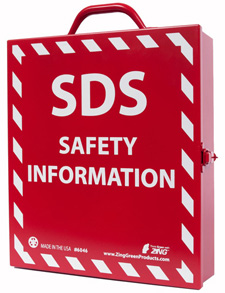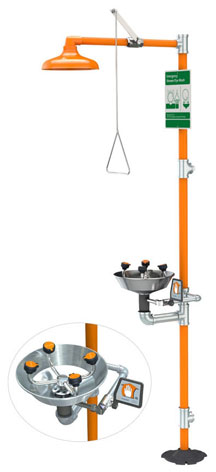| The Home page of ILPI's Safety Data Sheet (SDS) Resource, the leader in SDS information since 1995! | |
| The history and philosophy behind this resource. | |
| A curated collection of books and reference materials concerning Safety Data Sheets and closely related topics. | |
| Paste your plain text SDS into the SDS-Demystifier, and it will be converted into a hypertext-enriched document with links to detailed explanations of each key term. | |
| An extensive list of frequently asked questions about Safety Data Sheets including regulations, content, compliance, and more. | |
| A humorous take on Safety Data Sheet jargon. Fill in the blanks on our entry form to generate a personalized Unsafety Data Sheet to share with your coworkers. | |
| Since 1995, we've maintained this massive curated list of the best places to find Safety Data Sheets on the Internet. | |
| Way more than a glossary, this hypertext-enhanced resource covers hundreds of SDS-related terms and expert knowledge. Each entry includes both the SDS relevance and links to additional authoritative resources. | |
| Archived results of Safety Data Sheet related polls taken by some of our millions of site visitors | |
| You are here! The OSHA regulations behind SDS regulations, including the inspection guidelines and over 400 official interpretations letters under the Hazard Communication Standard | |
| Commercial suppliers of SDS authoring and management software as well as cloud compliance services. | |
| Commercial companies that will create SDS's for your specific needs as well as SDS translation companies. |

Safety signs, banners, and scoreboards? Get yours at Safety Emporium!
| Title: 07/10/1997 - Safety and Health regulations over large dairy farms. | |
| Record Type: Interpretation | Standard Number: 1910, 1910.111, 1910.142, 1910.145, 1910.266, 1910.1027, 1910.1200, 1910.1201, 1928 |
NOTICE:This is an OSHA Archive Document, and may no longer represent OSHA Policy. It is presented here as historical content, for research and review purposes only.
OSHA requirements are set by statute, standards and regulations. Our interpretation letters explain these requirements and how they apply to particular circumstances, but they cannot create additional employer obligations. This letter constitutes OSHA's interpretation of the requirements discussed. Note that our enforcement guidance may be affected by changes to OSHA rules. Also, from time to time we update our guidance in response to new information. To keep apprised of such developments, you can consult OSHA's website at https://www.osha.gov
July 10, 1997
Honorable Russell D. Feingold
United States Senate
Washington, DC 20510
Dear Senator Feingold:

OSHA compliance is a breeze with lockout/tagout kits, centers and stations like this one from Safety Emporium.
This is in response to your letter dated May 21, on behalf of your constituent, Mr. Jim Ostrum of Kaukauna, Wisconsin, and his questions pertaining to the Safety and Health Administration (OSHA) regulations over large dairy farms.
Dairy farms have a Standard Industrial Classification (SIC) code of 0241, which OSHA considers an agricultural or farming operation. For farming operations the regulations that would apply are found in Title 29 of the Code of Federal Regulations Part 1928 and Part 1910. Part 1928 contains OSHA standards for agriculture and Part 1910 contains the standards for general industry. A copy of the Part 1928 standards is enclosed.
Seven standards in Part 1910 also apply to farming operations. They are the standards for temporary labor camps (1910.142); storage and handling of anhydrous ammonia (1910.111 (a) and (b)); logging operations (1910.266); slow-moving vehicles (1910.145); hazard communication (1910.1200); cadmium (1910.1027, 1910.1200); and retention of Department of Transportation (DOT) markings, placards and labels (1910.1201). These seven standards have been marked with yellow flags in the two volumes of the Part 1910 standards that are enclosed.
OSHA's standards apply to all employers regardless of size. Therefore, all of the above standards would apply to both small and large dairy farmers. Also, OSHA's "general duty clause," Section 5(a)(1) of the OSH Act, could be applicable to dairy farmers in cases where a particular hazard is not addressed by any OSHA standard.
There is, however, a difference in OSHA's authority to enforce its standards. As you know, Congress has for several years restricted OSHA's enforcement activities regarding small employers by enacting an appropriations rider. The rider exempts small farming operations from enforcement of all rules, regulations, standards or orders under the Occupational Safety and Health Act of 1970 (the Act). A farming operation is exempt from all OSHA if it presently has or has had at any time during the previous 12 months, ten or fewer employees; and has not had an active temporary labor camp during the proceeding 12 months. Family members of farm employers are not counted when determining the number of employees.
OSHA's future regulatory powers over large farms, as over any employer, will depend upon what Congress determines is appropriate in light of the goals of the agency and the resources allocated to it.
To assist your constituent, you will also find Fact Sheet No. OSHA 97-04 which describes the OSHA Consultation Service. If your constituent wishes to contact the OSHA Consultation Service, he may contact the following:
For health issues:
Wisconsin Department of Health & Human Services
Division of Health
Section of Occupational Health, Room 112
1414 East Washington Avenue
Madison, Wisconsin 53703
Terry Moen, Chief
Telephone: (608) 266-8579
Fax: (608) 266-9711
For safety issues:
Wisconsin Department of Industry, Labor & Human Relations
Bureau of Safety Inspections
401 Pilot Court, Suite C
Waukesha, Wisconsin 53188
Jim Lutz, Acting Program Manager
Telephone: (414) 521-5063
Fax: (414) 548-8614
Your constituent may also contact the OSHA Regional Office that serves Wisconsin, which is:
Chicago Regional Office
Michael Connors, Regional Administrator
Sandra Taylor, Deputy Regional Administrator
U. S. Department of Labor - OSHA
230 South Dearborn Street, Room 3244
Chicago, Illinois 60604
Telephone: (312) 353-2220
Fax: (312) 353-7774
If you have any questions you may call Helen Rogers of my staff at (202) 219-8031, x121.
Sincerely,
John B. Miles, Jr., Director
Directorate of Compliance Programs
Enclosures

Your employees can stay informed and comply with OSHA regulations with SDS information stations and compliance products from Safety Emporium.
U.S. Department of Labor
200 Constitution Avenue, N.W.
Room N3468
Washington, D.C. 20210
To Whom It May Concern:
I am writing on behalf of a constituent, Mr. Jim Ostrum of Kaukauna, Wisconsin. Mr. Ostrum has questions pertaining to Occupational Safety and Health Administration (OSHA) regulations over farms, specifically large dairy farms.
Mr. Ostrum has contacted my office requesting detailed OSHA regulations outlining what farms of varying sizes must satisfy in order to be in full compliance with OSHA guidelines. Mr. Ostrum feels that there is a disparity in the regulations large farms must comply with versus the regulations small farms must comply with. Mr. Ostrum feels that large farms are required to follow the same regulations as large industrial enterprises, whereas small farms must comply with lesser regulations. Mr. Ostrum wonders if OSHA's regulatory powers over large farms will increase in the future as concerns over environmental and agricultural pollution grows.
I am confident you will address his concerns in a timely fashion. Thank you in advance for your cooperation. Please address any questions you may have to Dean Baldukas of my Middleton office.
Russell D. Feingold
United States Senator
The original official public domain version of this document is available from OSHA at https://www.osha.gov/laws-regs/standardinterpretations/1997-07-10.
